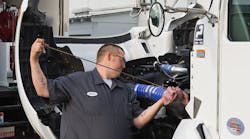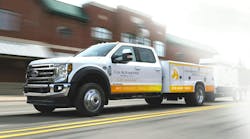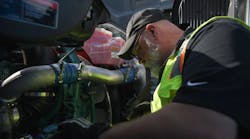As operational costs continue to rise, it is now more critical than ever to implement and follow dedicated preventative maintenance (PM) practices. But, even with the most optimized PM schedules in place, there are many additional tasks required of a fleet maintenance department, such as handling unexpected breakdowns, keeping up with the latest vehicle technology and technician training and assisting with or completing equipment spec’ing.
To address these needs, and ultimately aid in maximizing vehicle uptime, some fleets may choose to outsource their maintenance operations to a third party contracted service provider.
Reasons for outsourcing
There are a number of reasons fleets may opt to outsource maintenance. Considerations such as directing resources and attention to focus on the company’s core competency, addressing operational issues and keeping up with continued vehicle and tooling technology all play a role in a fleet’s decision to outsource.
From a financial and business strategy perspective, a company may choose to invest in other areas of the business such as marketing, expansion, product development, etc. and opt to not have maintenance be a core competency of their business.
“If transportation is not your company’s core business, then a full-service lease or maintenance program could be in your company’s best interest,” says David Rhodes, Area Operations Manager - East, Paccar Leasing Co. (PacLease).
A division of Paccar, PacLease is a commercial truck leasing company with options for full-serve leasing, rental and contract maintenance programs.
Specifically, as a business might expand within their market, through growth or acquisitions, they may reevaluate and determine they no longer want to focus on maintenance and upkeep for their vehicle fleet. Or, they may not have a maintenance facility in the new location. This focus on growth has led to a number of companies – with both small and large fleets – to turn to contracted maintenance.
“We’ve heard it from some very large customers – and when I say large, these are folks that have full-time associates responsible for maintenance,” says Gregg Mangione, senior vice president of maintenance for Penske Truck Leasing.
Penske Truck Leasing offers transportation and logistics solutions, such as truck rental and leasing, contracted services and more, with a network of more than 700 locations.
“(These larger fleets) probably have a pretty savvy procurement team, and things like that,” Mangione adds. “But even for them, this has gotten so large, they begin to say, ‘I’ve got a choice on where to invest my capital.’ You can either try to keep up with what it takes to properly maintain a truck, or focus that capital on growing (the) business. And, they’re focusing on growing their business.”
When it comes to operational concerns, this may involve anything from inefficiencies with current maintenance processes, spec’ing procedures or to the lack of skilled technicians. In addition to retaining talented employees, it can be a challenge to continually keep them trained.
There are benefits to the continued evolution of vehicle technology, but it can be a challenge for some fleets to keep up with truck componentry, electrical systems, system software and diagnostics on today’s vehicles.
Ultimately [innovations in trucking technology] will help reduce the overall operating maintenance of vehicles,” says Joe Gallick, senior vice president of national account sales for NationaLease. “But that requires that the shop personnel – the people who fix and maintain the trucks – that they are skilled and can diagnose repair issues and understand what the truck is telling them to make the repairs.”
NationaLease is a full-service truck leasing organization providing fleet management services with more than 900 U.S. locations.
Add to that complexity, it is critical to have the proper tools – and make sure technicians are adequately trained to use these tools – to aid in an efficient maintenance operation.
While all classes of vehicles can be serviced through contracted maintenance, Mangione confirms customers operating heavy duty trucks, and more specifically Class 8 tractor-trailers, are the most common.
“There is a lot of complexity in emissions, and maintaining that equipment, and the reliability with the tractors is more challenging than medium duty and light duty,” Mangione says.
“What we’re seeing is customers are becoming more and more focused on uptime on those assets,” Mangione adds. “The bigger the truck, the more expensive that asset, and the more mission-critical those deliveries are.”
Different types of contract services available
Available contracted services can be categorized into three main options, with degrees of customization. Those options include: dedicated carriage, full service and maintenance-only.
Dedicated carriage means the leasing company provides the drivers, equipment and full maintenance services. Full service refers to the leasing and maintenance of the equipment. Maintenance-only is just that – maintenance services for the fleet-owned assets.
Maintenance services are included in any of the contracted services above.
There are a variety of contracted maintenance services available, depending on the needs of the fleet. Some factors to consider include the current capabilities of the maintenance facility. Does the facility have the proper physical location, personnel, tools and equipment and training to keep up with demand, both currently and in the future? In addition, the fleet should determine the level of risk the facility is willing to take on, and how much control they’d like to have in the maintenance process.
When fleets are considering the outsourcing options available, a key question to address should be “How much control do they want to have over the final outcome?” NationaLease’s Gallick says. “You’re willing to take on more risk, as a fleet, in exchange for more control over the maintenance function.”
Different contract service providers have different names for these types of services, but in general they can be categorized as fixed-cost maintenance or variable-cost maintenance.
Fixed-cost maintenance agreement. Often referred to as a “guaranteed” maintenance agreement, this is a full-service maintenance product. Most often, fleets with newer equipment, or leased equipment, choose this option. Generally, it’s a fixed cost per month and/or fixed cost per mile for the life of the agreement. Average contracts are about five to seven years.
Fixed-cost maintenance agreements provide a “true picture, looking forward, of budgetable expenses around maintaining that fleet,” Gallick explains. “With the exception of accidents and things caused by drivers, the costs in that contract are guaranteed. There is less risk for the customer and the fleet, but (the fleet is) giving up control of the maintenance function to a third party.”
On average, fleets with vehicles three years or newer would benefit from a fixed-cost maintenance agreement.
Variable-cost maintenance agreement. There are varying degrees of customization based on the services a fleet selects with variable-cost maintenance contracts, dependent on how much control the fleet would like to keep. In general, a fleet may pay a low fixed cost for minimal PM services, and pay additional for each follow-up or unexpected maintenance or repair event. Other fleets may opt for minimal contracted services such as pre-negotiated rates for discounted parts pricing or lower hourly labor rates.
“The risk they’re taking on is that costs are less predictable than guaranteed maintenance, because you don’t know what you’re going to find and have to maintain,” Gallick says. “But, they’re at or below retail-level pricing. And, the customer gets complete visibility on their spend.”
Penske calls its variable-cost maintenance model “peg” maintenance. The term “peg” refers to setting a certain budget total per month, paying a variable monthly amount for anything over that budgeted amount. (For instance, in the case of “zero-peg” the customer does not have a set monthly budget and instead pays a variable cost per mile, each month).
“This is a better product for customers with older equipment in that, the older a vehicle is, the greater the unknowns are with maintenance,” says Penske’s Mangione.
He confirms fleets with vehicles that are in the range of four to six years, or older, would make sense for this type of maintenance contract.
Variable-cost maintenance agreements are usually for fleets that own their own equipment, and the equipment is typically not brand new or is not relatively new. Because the equipment may be older, it is more challenging to guarantee the maintenance costs. This is for two reasons, according to Gallick. As equipment ages it requires more routine maintenance in general: “They missed that low end of the total life maintenance curve.” Plus, there is more guesswork to determine if PM schedules were followed before both parties enter into the maintenance agreement.
A variable maintenance agreement typically has a regular fixed cost, along with an adjustable maintenance rate changed based on regular analysis of maintenance and service. Adjustments can be made on a monthly, quarterly or annual basis.
“The cost per mile could be different for different vehicles in the fleet, because they are different ages, at various mileages,” adds Gallick.
Overview of the process
There are a number of steps involved with entering into a contract with a maintenance service provider. These include a thorough evaluation of current practices, operational issues and service provider options; the implementation and adoption of a contracted maintenance program; and follow-up.
In order to determine the viability of contract maintenance, the first step is to conduct a thorough analysis of the maintenance operation. This initial evaluation can be completed internally by the shop, or contracted service providers can aid in providing an evaluation.
PacLease prefers to conduct the evaluation of the customer’s fleet, says Rhodes.
“We visit the customer, or have them bring (vehicles from the) fleet to one of our service locations. We would like to rotate the fleet through our shop,” Rhodes adds. “When we have their units, we do have a certified PacLease technician inspect the tires, take an oil sample and make sure the unit is up to DOT compliance.”
Mangione advises Penske also provides an initial inspection of vehicles.
“That’s where you’re collecting the specification data, but a lot of times the customer wants a snapshot of the condition of their fleet, both from a maintenance perspective, physical damage, and then where do they stand from a PM standpoint,” Mangione says. “That sets your pace, if you will.”
This evaluation establishes a baseline for follow-up after the contracted maintenance is adopted. If the fleet decides to partner with a contract maintenance service provider, they should then identify any potential barriers to implementation. Barriers may include determining where the maintenance will be completed, completing a cost analysis and communicating with management and employees.
It is more common for location-based and medium- to large-sized fleets to consider having a dedicated on-site maintenance operation, run by a third party company. Smaller fleets, or network-based fleets, may find more benefit in partnering with a contract maintenance provider with multiple locations and multiple customers.
“If we have an existing, multi-client location facility in the area, it may make more sense for the customer to use their own real estate for something else, and just outsource it completely to our multi-client facility,” says NationaLease’s Gallick.
A cost analysis may reveal a higher-than-expected up-front cost to bring the vehicles up to current maintenance schedules.
“Part of the reason they have chosen to outsource is because they’ve struggled to get visibility of their total cost of ownership through whatever systems they were using. Sometimes there’s a little sticker shock and you have to talk through that,” Mangione says.
This can be a challenge in particular for an older fleet, where deferred maintenance means more vehicle updates and repairs to bring the vehicle up to current maintenance schedules.
“Sometimes we have to work through getting that vehicle caught up,” Mangione says. “But a lot of that conversation is, we don’t want to short-change things that impact improving the reliability of the truck. That’s the whole point of the program.”
Mangione adds that DOT-compliance items are required, and will take priority when bringing vehicles on-board to their contracted maintenance programs.
Once a fleet selects the service provider, a documented plan should be created and implemented.
In other words, take action to have the contracted maintenance provider take over the maintenance operations. The type of program selected, and whether the contracted service provider will be on-site or the vehicles will be serviced at a multi-customer location, can determine the time it takes to be up and running.
“Typically from a 30-day timeframe from signing the contract, we’ve got the customer operational,” Mangione says. “The two key things are to get unit numbers on the trucks so they can be identified in the system, and to get the trucks and specifications in our system.”
Follow-up is crucial to the continued success of any maintenance program, including contracted services.
Many contract service providers provide this continued monitoring in the form of regular reports to confirm the success of the program, and verify where changes can be made for continued improvement. Communication with the fleet manager, or other management overseeing the maintenance department for the business, is critical.
Benefits to outsourcing
Contract maintenance providers have the added benefit of working on a larger scale. This affords them the ability to receive discounts on parts and equipment pricing, oftentimes passing that discount on to customers. Contracted service providers can review and assess more equipment on a regular basis, and provide that feedback to customers. Plus, standardized practices when it comes to PM schedules and staff training across the company also ensures operational consistency for all facilities.
“In many ways, NationaLease operates as a group purchasing organization,” Gallick says. “We are buying parts and supplies at significant discounts. So even when we mark that part up – let’s say a filter or tire, to a customer – they’re still getting it at a price that’s usually better than they can negotiate themselves.”
Working with multiple companies also gives contract maintenance providers the advantage of developing and maintaining relationships with not only a number of different fleets, but also a variety of vendors and manufacturers. These relationships aid in providing real-world knowledge that can be applied to a wide variety of customers’ maintenance operations.
Because of this, contracted maintenance providers can keep up on new vehicle technologies and new tools and equipment.
In addition, the contract maintenance provider can offer additional and continual training opportunities for technicians and drivers, due to the company’s familiarity with different aspects of the business.
Due to this larger operating scale, contracted maintenance providers may be qualified to complete warranty work as well.
“If you have a service provider that can file warranty claims directly to the OEM, that tells me the OEM has come to their facility, inspected their tooling and practices and they approved it,” says PacLease’s Rhodes.
As it relates specifically to each customer, contract maintenance providers aim to provide visibility and transparency with the maintenance process. This means communication is critical to the success of the service.
Ways in which contract maintenance service providers communicate include data and reporting on the status and performance of the fleet, active alerts to trends within the fleet and the status of field and roadside events.
“The beauty of an outsourced maintenance program is that we’re collecting all that data – that cost and maintenance data, and we’re able to provide it to the customer in a way that they can make better decisions on spec’ing their equipment, or using their equipment,” says Gallick.
“We’ve also invested in fleet maintenance technology, and accounting and business process technology, so we’re able to provide a customer with electronic metrics and scorecards so they can see real-time performance of their fleet and where they’re spending their money, to make better decisions on replacing equipment, the types of equipment they may want to reinvest in,” Gallick adds.
Rhodes also confirms PacLease aids in providing telematics and vehicle performance data.
“We will provide our customers with things like improved fuel economy recommendations,” Rhodes says. “We also look at the trip logs – we can plug into their ECM and start pulling (information like) hard brakes, if the driver is overspeeding to see if they need driver training, things like that.”
For those operations which require multiple service locations, contract service providers provide efficient handling of unplanned over-the-road events or breakdowns, and of keeping maintenance services consistent.
“You may be a truck or tractor that’s a few states away and you have a breakdown; that vehicle can go into any Penske location for service,” Mangione explains. “Or if they’re on the side of the road with a breakdown, our roadside assistance team (will) handle the call from the driver and coordinate with the local Penske location to get that vehicle repaired, or maybe running back down the road in one of our rental vehicles.”
Conclusion
Ultimately, considerations for contracting maintenance come down to the ability to handle the maintenance and repairs, forfeiting control in exchange for less risk.
“A lot of customers who have done this, they are giving up some control – either they’re dealing with a vendor that their people had a comfort level with from a communication standpoint, or if the customer did it in-house – that’s the ultimate in visibility and control,” Penske’s Mangione says. “We have all the systems to provide that visibility.”




